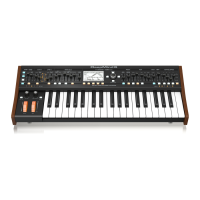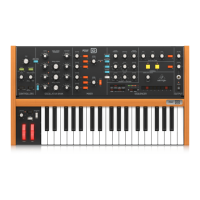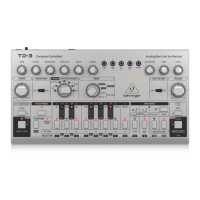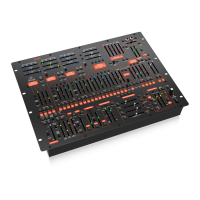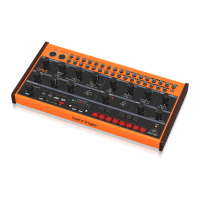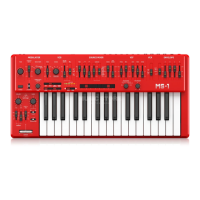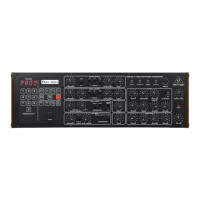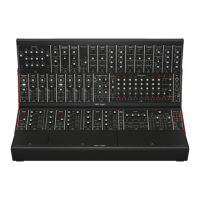147 DeepMind 12 User Manual
Digital Signal Processing (DSP): The numerical manipulation of signals,
usually with the intention to measure, lter, change, eect, produce or compress
continuous analog signals.
Distortion: An eect based on pushing the boundaries of what a specic
technology or implementation can achieve. At the point where technology
begins to overload, overdrive, clip, saturate or generally misbehave is where
distortion starts to appear. Examples include tape, valve, transistors, and also
digital algorithms and processes.
Dynamic: The range of levels in an audio signal, from the softest to the loudest.
Dynamic Processor: A device used to control and/or change the dynamics
of a signal.
Dynamic Range: The dierence between the lowest level and the highest level
an audio system can produce.
Edit / Editing: The combined methods of creating a program from a starting
point or program.
Edit Buer: A temporary storage memory for a program.
Eect: One of a number of audio processes that can be applied to a signal to
modify it, such as reverb, anging, phasing, delay etc.
Eects Send: A copy of the channel signal which is sent to an eects processor
in order for it to be returned.
Eects Return: An eected audio signal which is returned to mix with the
original channel signal.
Envelope Generator (EG): An envelope signal which can be adjusted to a
specic shape in order to control the way a sound behaves over time.
Equalisation (EQ): Processor used to adjust the volumes of various frequency
ranges for creative or corrective purposes.
Exponential: A mathematical function of growth or decay where the
independent variable is the exponent. This results in a "hockey stick"
shaped curve.
Expression Pedal: A Pedal which can be connected to an expression input and
used to send a control signal dependant on the position of the pedal. The control
signal can then be used to modulate other parameters, and/or to add expression.
Fader: A physical linear control also known as a slider, or slide potentiometer
which can be used to adjust a parameter.
Feedback: A loop created between an audio input and an audio output of an
audio circuit, system or processing block.
Filter: A device that attenuates certain frequencies while letting other
frequencies through. Using a lter to reduce harmonics, changes the timbre or
color of the sound.
Flanger: An eect that mixes a slightly delayed copy of the signal with the
original signal, producing a linear harmonic comb lter response. The copy’s
delay time is modulated by an LFO which results in jet-like sounds suitable for
sweeps, and can also be used to add metallic type resonance to a sound.
Frequency Modulation (FM): Using one frequency to modulate another
frequency's pitch. When the modulation source is in the audio range, it can be
perceived as a change in the timbre or color of the sound. FM can be used to
create a wide range of rich and complex sounds and is often described as having
a clear and distinctive timbre.
Frequency: The number of times that a sound waves cycle repeats within
onesecond.
Fundamental Frequency: The lowest frequency of a periodic waveform.
Gain: The amount of signal level increase provided by an amplier stage.
Gate (Synthesizer): A signal used to trigger an event, such as a note
or an envelope.
Gate (Dynamics): A device used to cut o the level of a signal when it falls
below a specied threshold. Can be used to cut background noise, control reverb
tails, or creatively to produce chopping type eects.
Glide: See Portamento.
Globals: The settings and parameters which govern the general operation of the
synthesizer and are not directly associated with the voice engines.
Harmonics: A series of integer-related sine waves at varying levels creating
dierent timbres. Waveforms (other than a pure sinusoidal) generate various
harmonics which help dene the character of the sound.
Hertz (Hz): A unit of frequency equal to one cycle of a wave per second.
High Pass Filter (HPF): A lter that attenuates lower frequencies from a signal,
leaving the higher frequencies unaected.
Hum: Undesirable low-frequency tone (typically 50 or 60 Hz) present in a signal
due to grounding problems or proximity to a power source or power cables.
Impedance (Z): Opposition to the ow of alternating current in a circuit,
measured in Ohms.
Insert: A point in a processing chain where a device can be inserted.
Keyboard: A range of keys, arranged in order of ascending pitch, which enables
the synthesizer to be played by hand.
Keyboard Tracking: Allows the control signal from played keys to adjust
another parameter. Commonly used to open a lter as higher notes are played
which then enhances harmonics.
Kilohertz (kHz): A unit of frequency equal to one thousand cycles of a
wave per second.
Latency: A delay introduced by processing. Measured by the time it takes to
produce a signal after a request has been made. In a synthesizer, it is the time
taken to produce a note after a key has been played. In an audio interface, it is
used to measure the time it takes for an input signal to reach the processor, or for
a signal from the processor to reach the output.
Level: Used to describe the magnitude of a sound, often relative to an
arbitrary reference.
Limiter: A device used to limit the level to a range of values irrespective of the
input level.
Linear: Used in audio to describe a straight line response of circuit or
process which results in a change which is directly proportional to an
independent variable.
Line Level: A nominal operating level used by audio equipment. Professional
line level is normally +4 dBu and consumer line level is -10 dBv.
Looping: Automatically restarting a function at the end of a period of time or
dened cycle, to create a continuous loop.
Low Frequency Oscillator (LFO): An oscillator that commonly runs at a very
low speed and is used to modulate another parameter.
Low Pass Filter (LPF): A lter that attenuates higher frequencies from a signal,
leaving the lower frequencies unaected.
Mark to Space Ratio: The ratio between the positive and negative parts of a
rectangular waveform, or pulsewave.
Memory: Digital storage of information/data.
Meter: Visual device to indicate the level of a signal.

